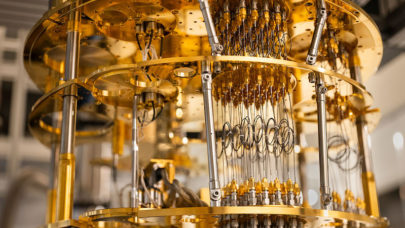Supercomputer maker SGI has launched its next generation ICE supercomputer, the company’s flagship scale-out HPC cluster platform. Using Intel’s latest Xeon processors, ICE-X is up to two and half times as dense and twice as fast as the current ICE 8400 system. “We expect to extend our share in the large-scale cluster market significantly with the new SGI ICE X, as it is designed for scale, speed and density,” said SGI CEO Mark J. Barrenechea, in a press announcement released on Monday.
According to Paul Kinyon, SGI’s director of product marketing for the scale out server business, the new ICE-X, which is codenamed “Carlsbad 3.0,” represents the largest performance boost in the company’s five generations of ICE machines. Most of this is due to the newest crop of x86 CPUs and InfiniBand parts. Specifically, the initial products will be powered by Intel’s upcoming Sandy Bridge Xeon CPUs, the 8-core Xeon E5s, and employ the latest and greatest FDR (Fourteen Data Rate) InfiniBand technology.
But, said Kinyon, much of the engineering effort was directed at optimizing density and cooling for the platform. In the most compact configuration offered, a single rack can house 288 CPUs, or 2,304 cores. Depending on the specific configuration and wattage on the selected Xeon parts, traditional air-cooled heat sinks or liquid cold sinks are employed.
The system design is modular, based on a 9.5U enclosure. Each one can house 18 blades slots (more about what that entails in a moment) and two InfiniBand switches. (The switch is an SGI custom job, employing Mellanox’s 36-port FDR InfiniBand ASIC.) Two enclosures are paired together, with a power supply shelf sandwiched between them, to make a 21U building block. Two of these building blocks can be stacked into a standard-height 42U rack.
 As far as the blade themselves, they come in a couple of models: a single-node board (Dakota) or the double-node twin blade (Gemini). In both versions, each node is a dual-socket board with an attached mezzanine board that holds the FDR InfiniBand adapter, in this case, a Mellanox ConnectX-3 HCA. The mezzanine is connected to the main board with PCIe Gen 3 links, which is necessary if the FDR adapter is to run at its full 56 Gbps speed. Since the Xeon E5 processor has PCIe Gen 3 support built-in as well, all the componentry will support FDR, and eventually EDR.
As far as the blade themselves, they come in a couple of models: a single-node board (Dakota) or the double-node twin blade (Gemini). In both versions, each node is a dual-socket board with an attached mezzanine board that holds the FDR InfiniBand adapter, in this case, a Mellanox ConnectX-3 HCA. The mezzanine is connected to the main board with PCIe Gen 3 links, which is necessary if the FDR adapter is to run at its full 56 Gbps speed. Since the Xeon E5 processor has PCIe Gen 3 support built-in as well, all the componentry will support FDR, and eventually EDR.
The main difference between the blades is that Dakota can support up to eight DIMMs per socket and has three InfiniBand mezzanine board options (single-port, dual-port, and dual single-port), while the Gemini blade supports only four DIMMs and offers just the dual single-port InfiniBand mezzanine board. Essentially the denser twin blade offers twice the compute, but trades off memory capacity and some flexibility on the InfiniBand interconnect.
At the rack level, SGI offers two flavors (and widths) : the 24-inch D-rack and the 28-inch M-rack. The D-rack is the less dense version and can only house the Dakota blades. It maxes out at 144 sockets. The M-Rack can take either the Dakota or Gemini blades, and with the latter can hold 288 sockets. For comparison, the current ICE 8400 rack tops out at 128 sockets and is a couple of inches wider than the M-Rack.
Cooling defaults to the air-cooled heat sinks, until you get to the Gemini twin blade, where the cold sinks are used if you start outfitting those denser blades with the top-end Xeon CPUs. At the time of this writing, Intel has not revealed the speeds and feeds on the Xeon E5 processors line, so all Kinyon could say was that they will support the whole range of E5 SKUs up to and including the fastest (and hottest) 130 watt CPUs. In general, anything over 95 watts is in need of a cold sink, which sits right on the processor.
SGI also supports a memory subsystem as befitting an HPC machine, in this case, DDR3 DIMMs running at 1600 memory transfers/second. When you have 16 DIMMs per node, as is possible with the Dakota blade, that translates into a lot of aggregate bandwidth. “In HPC, memory bandwidth is king,” said Kinyon, “so the ability to have more DIMMs running at the highest frequency possible is a big deal.”
The only down side to all this dense packaging is that there really is no space for external PCIe slots to add, say, a GPU or flash memory card (although a SATA drive slot is available to hold an SSD). Kinyon said there is a way to hook up GPUs, but it must be done externally with what SGI calls “specialty nodes.” The advantage here, he said, is that the GPU to CPU mix is much more flexible and dynamic.
Although ICE-X scales up into the tens of petaflops realm, customers can buy much smaller systems, down into the tens of teraflops. In fact, existing customers can add ICE-X racks to their older ICE machines with relative ease. One such customer is NASA, owners of the 1.35-petaflop Pleiades supercomputer, which is already the largest SGI ICE cluster in the world.
The plan is to add 1,700 ICE-X nodes on top of the existing Pleiades system, which currently has of two generations of ICE gear. Thanks to the hypercube InfiniBand topology of Pleiades, SGI can upgrade the system while it’s running, with no downtime for users. Kinyon said you just bolt it together, cable it up, and the system management software will automatically bring the new nodes into the cluster.
The additional ICE-X nodes will bump Pleiades’ peak performance by about 575 teraflops, but since a couple of hundred teraflops of the older, slower servers will be removed (due to space considerations), the space agency will end up with about 1.7 petaflops. The upgrade is slated to be complete by early 2012.
Not all ICE-X configurations will be available by then, however. The Dakota blade will ship in late Q4 and the Gemini blade will be available a few months after that, in the first quarter of 2012. Some of the cooling options and InfiniBand mezzanine boards won’t ship until the first quarter of next year, and in the case of the cold sink, the second quarter.
Beyond that, future ICE systems will be on a two-year cadence. The next iteration, codenamed Carlsbad 4, is tentatively slated for 2013 and will support EDR InfiniBand. Carlsbad 5 is due in 2015 and will use whatever InfiniBand generation is ready in that timeframe. CPUs and memory technology will move up accordingly with each new generation.




























































